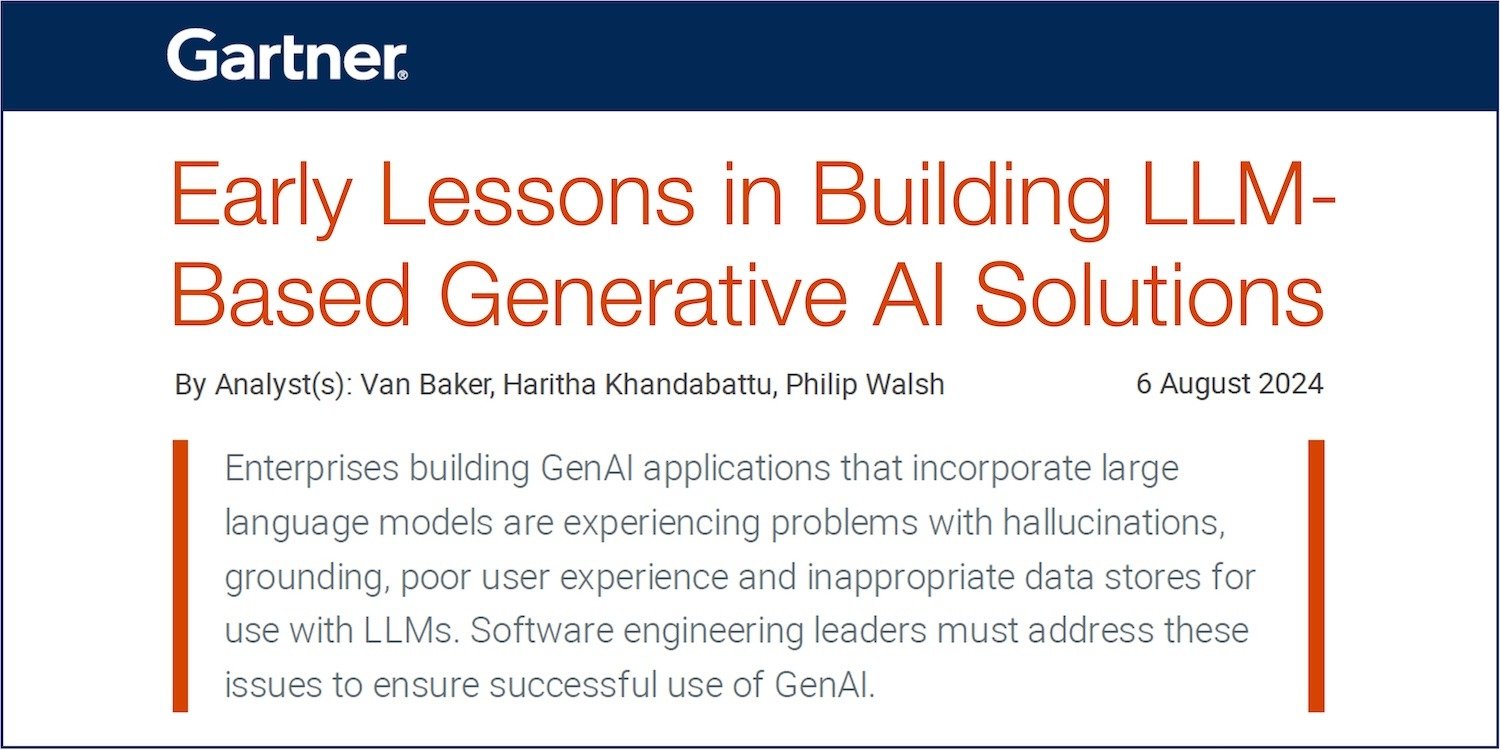Generative AI can boost productivity and innovation, but its adoption can be challenging. Learn about GenAI best practices from Gartner analysts.
The GenAI imperative
Organizations today are racing to integrate generative AI (GenAI) powered by Large Language Models (LLMs) into their operations. They’re adopting emerging generative AI frameworks, like Retrieval-Augmented Generation (RAG), to inject trusted enterprise data into their LLMs – in the hope of responding more quickly and reliably to user queries.
However, many now face unexpected challenges regarding implementation, accuracy, and usability. These challenges cause many to question, what is a best practice when using generative AI?
Understanding how to successfully deploy and use GenAI is essential for realizing its potential. This article provides an in-depth summary of the recent Gartner report, Early Lessons in Building LLM-Based Generative AI Solutions, highlighting key findings and actionable recommendations.
Get the Gartner report on GenAI best practices FREE of charge.
GenAI key challenges
Deploying GenAI applications that leverage LLMs has proven to be more complex than many enterprises initially expected. Some of the biggest challenges are:
-
Hallucinations and inaccuracies
LLMs can generate content that is factually incorrect, a phenomenon commonly called AI hallucinations. OpenAI has noted that these inaccuracies can occur in over 30% of outputs – posing a significant barrier to trust and usability, particularly in customer-facing applications.
-
User experience issues
Interacting with an LLM is a different experience than using a visual UI in an application. Employees might find it challenging to adapt to the new prompt/response interaction model leading to lower adoption rates, suboptimal LLM responses, and diminished perceived value.
Gartner forecasts that over 50% of generative AI solution deployments will fail by 2026, primarily due to such challenges. Implementing best practices when using generative AI is crucial for organizations aiming to overcome these hurdles.
What are best practices when using GenAI?
1. Use RAG to ground your LLMs
A fundamental best practice is LLM grounding based on reliable data. Grounding refers to the process of providing LLMs with accurate, contextual information to improve the quality and accuracy of their outputs.
Retrieval-Augmented Generation (RAG) is a technique that involves supplementing prompts with relevant data drawn from internal information stores, such as CRMs, knowledge bases, and other enterprise systems. Grounding your LLM can significantly reduce inaccuracies and enhance the overall reliability of the generated content.
While RAG seems like it should be a straightforward process, it’s proving to be more challenging than many enterprises originally anticipated. For example, if you’re trying to ground your LLM using RAG for structured data – typically via LLM text-to-SQL queries – the generated output often lacks the context your model needs to produce a meaningful response.
2. Add metadata to ensure data readiness
The RAG challenges described above result from the fact that, for the most part, enterprise data stores, like data lakes and data warehouses, simply weren’t designed to deliver data to LLMs.
Adding metadata to your data stores can further refine the data used for grounding. Metadata helps ensure that your LLM receives the most relevant and accurate information, which is critical for producing high-quality outputs.
Research also suggests that a hybrid retrieval approach, that aggregates data from several different sources, provides better results.
3. Prepare your workforce for effective use of GenAI solutions
Here are best practices that have proven helpful for maximizing employee adoption:
-
Develop comprehensive training programs
Providing structured training on AI prompt engineering is vital. Employees should learn how to formulate specific, detailed prompts that guide LLMs to generate relevant content. Training should also cover common pitfalls, such as the tendency to use overly simplistic or vague prompts.
-
Promote sharing of best practices
Encourage employees to share their insights and strategies for using GenAI. Establishing collaborative platforms, such as internal forums or chat channels, enables this exchange and ensures that your data teams learn from each other's experiences.
-
Improve the user experience
The user experience of many LLM applications can be frustrating, particularly for those accustomed to traditional software interfaces. To enhance usability, organizations should consider developing a more guided and structured dialogue approach.
Drive GenAI adoption with best practices
As the landscape of AI continues to evolve, you need to stay informed and adaptable to achieve long-term success. By implementing the best practices covered in the Gartner report, you can overcome the challenges associated with implementing GenAI solutions and unlock their full potential to drive innovation and enhance productivity.
Discover GenAI Data Fusion, the K2view suite of RAG tools
that enables the entire range of generative AI best practices.














